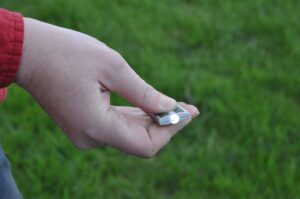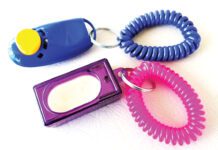
Dogs are masters at noticing body language, which makes them great at learning hand signals. When it comes to training a deaf dog, hand signals are the name of the game.
Here are five things to keep in mind when working with a deaf dog:
- Attention is key. Teach your deaf dog to orient toward you using a variety of non-verbal cues. A tactile cue, such as gently tapping your dog on her side, a gestural cue like waving your hand in a distinct pattern or stomping your feet to create a vibration can all work well when your dog is within arm’s reach or otherwise close enough to perceive the cue.

To teach each of these cues, pair them with treats or the presentation of a favorite toy. Admittedly, using food is often the easiest but toys can work, especially with highly toy-motivated dogs. (If your dog is indifferent about food and toys, we recommend working with a skilled positive reinforcement trainer who can help you think outside the box when developing your training plan.)
Gently tap your dog, wave your hand when he can see you, or stomp your foot and immediately feed a treat or present the toy. Start when your dog is already paying attention and repeat often without distractions to keep the sequence super easy; then try it when your dog is mildly distracted and not looking at you. Your dog will learn that feeling the tap, seeing the wave, or feeling the distinct floor vibration of your attention-getting stomp means you’re about provide something he wants, which is a good reason to pay attention. A bonus of teaching a tactile cue is that it also helps desensitize your dog to unexpected touch, which reduces the natural startle reflex in other circumstances.
- Reward well for offered check-ins and teach an “all done” cue. With attention and eye contact being so important, be sure to notice and reward moments when your dog offers attention to help him understand keeping his eye on you is a good thing. When out walking your dog, remember to be present and don’t get lost in looking at your phone! At the same time, when you want your dog to settle and understand there won’t be any interaction for a while, teach an “all done” signal. We like the American Sign Language sign for “finished,” but any gesture can work if it’s consistently followed by the absence of interaction.
- Choose your hand signals. When teaching behaviors using a lure (often done using a treat in front of the dog’s nose), it’s easy to fade the treat and use the same physical gesture as a cue for the behavior. For example, if you first teach a dog to lie down by having her follow a treat in your hand from her nose to the ground, pointing from nose-level to the ground can become your “down” signal.
Teach a visual marker, such as a quick thumbs-up gesture or a flash from a small flashlight, to let your dog know when he’s been successful or is on the right track and a reward is on its way. (With hearing dogs, we often use a verbal marker (such as the word “Yes!” or “Good!”) or the click of a clicker to indicate the dog has done what we want, just before we deliver the treat.)
- Consider using a vibration collar. A vibration-only collar can be a useful tool with some deaf dogs, especially when your dog is far away, has his back turned, or is otherwise distracted. A good use of the vibration collar is as a recall cue, where feeling the vibration means race to your person for something great!

Begin by pairing the sight of the collar with something great – like a tasty treat. Then let the collar vibrate in your hand and feed treats as your dog investigates. Progress to holding the collar against your dog’s body as it vibrates, beginning at his shoulders and moving up to his neck. Each time the collar vibrates, feed a treat. Work this process slowly over a few days to really help your dog understand that vibration equals tasty treat. This will help build a positive conditioned emotional response (CER) in your dog’s mind: Vibration equals chicken. Chicken equals yum. Therefore, vibration also equals yum. Quick! Race to my person to get the yum!
You’ll know the positive CER is setting in when, once you put the collar on your dog and activate vibration, he immediately orients toward you with a hopeful expression in anticipation of a treat. Add distance and distractions slowly over time and your vibration turns into a recall cue. Be sure to pay generously each time to make sure it’s “worth it” for you dog to leave a distraction to come to you.
Keep in mind, some dogs, no matter how slowly you progress, will be worried about the vibration, in which case a vibrating collar is not the best tool. And no matter how great your deaf dog’s recall turns out to be, it’s best to stick to fenced-in spaces or use a long line when you want him to enjoy a bit more freedom. No dog’s recall is perfect and with one fewer sense to engage, it can be harder to round up a loose dog or track down a lost dog.
- Talk to your deaf dog! Your deaf dog may not be able to hear you, but the more natural you are in your behavior, the more natural your body language becomes, including your facial expressions. Breathe. Relax. Smile. She may not hear your words, but she’ll learn a lot through your facial expressions, unique body language, and behavior patterns as you build and strengthen your bond.





